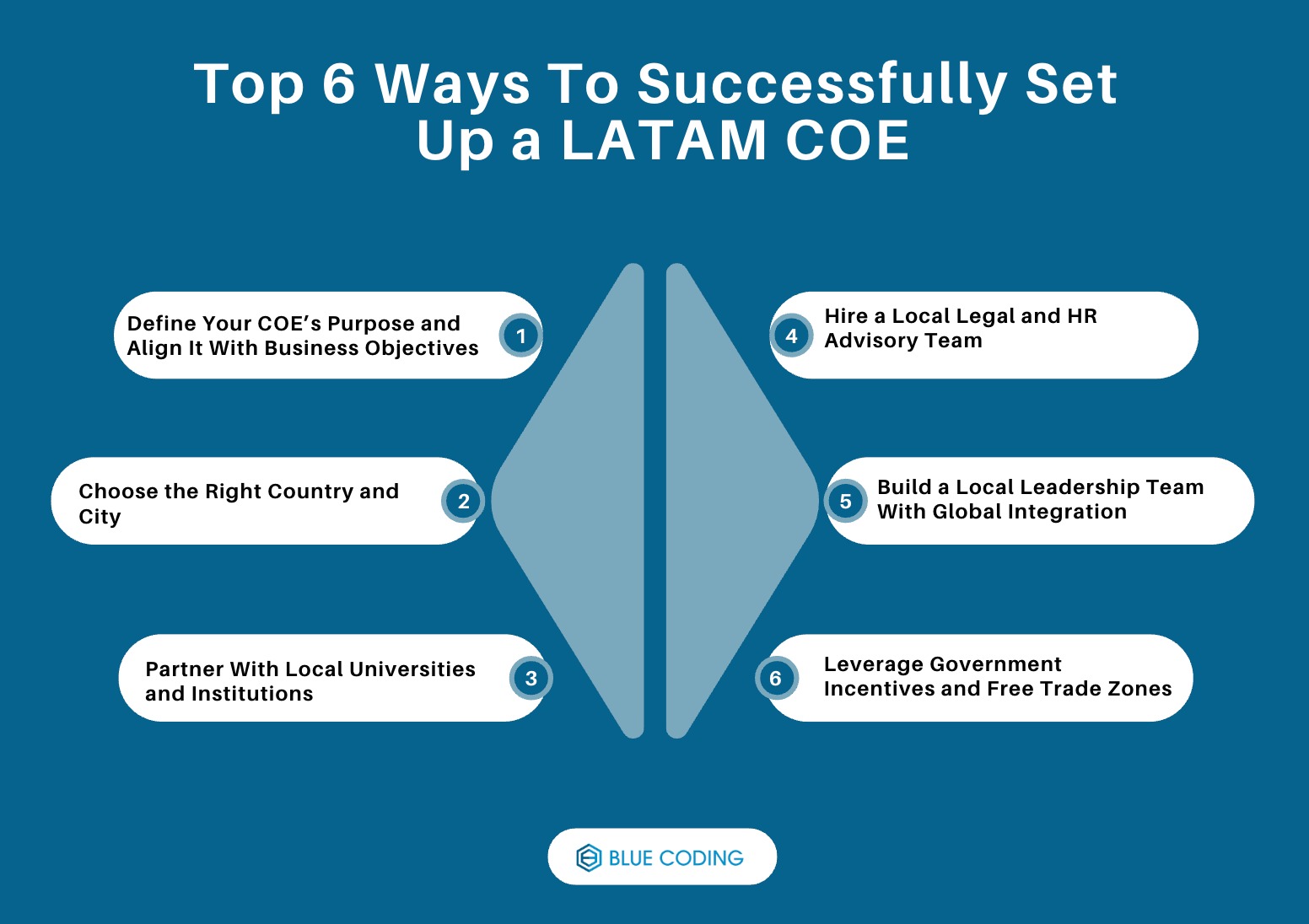 News
News
If you've been paying attention to the global tech scene, you’ve probably noticed something: Latin America is no longer flying under the radar. It’s showing up in conversations about innovation, remote teams, and global delivery, and for good reason. From government-backed incentives to an ever-growing pool of tech talent, LATAM is proving itself as a serious player. So, if you’re thinking about setting up a Center of Excellence (COE), this region might just be your smartest move yet. But it’s not just about picking a country and hiring fast. Building a successful COE in Latin America takes strategy, local insight, and a real understanding of how to plug into the ecosystem the right way. Let’s break down what it takes to do it right, step by step.
Why LATAM Is Earning Its Place on the Global Tech Map
If you’ve been keeping an eye on where software development is heading, you’ve probably noticed that now, LATAM keeps showing up again and again. And it’s not by accident. This region is building real momentum across every angle of tech, from infrastructure and government policy to talent and culture. Let’s break down some of the biggest reasons why LATAM is now considered a true center of excellence in software development.
Free Trade Agreements That Open Doors.
Ever wondered why so many U.S. companies are setting up development partnerships in LATAM? A big reason lies in the region’s growing number of free trade agreements. These agreements, such as the USMCA (United States–Mexico–Canada Agreement) and various bilateral treaties, make it much easier to collaborate across borders. They reduce tariffs, simplify legal frameworks, and support smoother intellectual property exchanges, all of which matter when software development is involved. For tech companies, this translates to fewer headaches and faster onboarding of skilled LATAM developers into long-term projects.
Cloud Giants Are Investing in LATAM.
When companies like AWS, Google Cloud, and Microsoft Azure start building local data centers, you know something big is happening. Over the past few years, LATAM has seen a wave of cloud infrastructure investment. Countries like Brazil, Chile, and Mexico are becoming regional cloud hubs with localized hosting that cuts latency and strengthens data security. For software teams, this means faster deployment times and better service for users in the Americas. And for clients? A seamless user experience powered by serious backend support.
The Region Is Remote Work Ready.
LATAM’s fast-growing tech scene didn’t wait around for remote work to become a global trend. It embraced it. From Argentina to Colombia, developers have been building remote-ready careers for years. High-speed internet in urban hubs, tech coworking spaces, and widespread access to remote tools have created a culture that thrives online. Add to that a workforce comfortable with Slack standups, Jira boards, and async workflows, and you’ve got a region that’s already speaking the language of distributed teams.
Outsourcing Isn’t a Gamble Here.
There’s a reason companies are betting big on LATAM for long-term development projects. Many Latin American governments have taken serious steps to stabilize and support their IT outsourcing sectors. Whether it's through export incentives, digital infrastructure investment, or local tech incubators, the groundwork is solid. Unlike some regions where outsourcing can feel like a high-risk leap, LATAM offers consistency. You’re not just hiring developers. You’re building a partnership in a region where software outsourcing is a national priority.
Bilingual Talent That Gets the Brief.
When your dev team understands both the code and the context, everything runs smoother. LATAM offers a growing number of bilingual software engineers who can collaborate with North American teams without missing a beat. Many developers have studied in English-speaking institutions or have previous experience working with U.S. companies. This means fewer translation errors, more productive meetings, and higher-quality outputs. Communication doesn’t become a bottleneck. It becomes a strength.
Hackathons and Bootcamps Are Fueling Innovation.
Tech talent in LATAM isn’t just skilled. They’re driven. Hackathons, coding challenges, and intensive bootcamps are regular fixtures in the region’s tech culture. These events are more than just competitions. They’re real-world testing grounds where developers refine their skills, build teamwork, and experiment with new technologies. For hiring companies, this translates into talent that’s hands-on, adaptable, and already comfortable with high-pressure problem-solving. It’s a region full of coders who don’t just build. They iterate, compete, and innovate.
Top 6 Ways To Successfully Set Up a LATAM COE

Establishing a COE in Latin America can be a smart move, especially if you’re looking to tap into skilled talent, expand operations, or streamline your global delivery. But to make it work, you need more than just a great idea and a few job postings. Here's a closer look at six of the most important steps to help you build a strong and scalable COE in the region.
1. Define Your COE’s Purpose and Align It With Business Objectives
Before choosing a location or hiring talent, you need to be clear about why you’re setting up a COE in Latin America in the first place. Are you building it for software development, product innovation, back-office support, or something else entirely? Defining its core function early helps you make decisions faster and with more focus. But it doesn't stop there as your COE’s role should also tie directly into your broader business strategy. For example, if your goal is to expand your global product development capacity, your COE should be structured around agile product teams, R&D, or prototyping capabilities. This alignment ensures that the COE doesn’t become a silo but stays integrated with the rest of your company’s goals and direction.
2. Choose the Right Country and City
Latin America offers plenty of choices, but each country comes with its own strengths, challenges, and costs. Mexico stands out for its proximity to the U.S. and solid nearshoring potential, while Colombia is becoming a hub for fintech and innovation. Brazil offers access to one of the largest talent pools in the region, though it may have more complex regulations. Within each country, specific cities like Guadalajara, Medellín, or São Paulo often offer better infrastructure, stronger tech ecosystems, and more access to skilled professionals. Don’t rush this step, take time to research and compare. Consider factors like political stability, internet reliability, the local cost of living, time zone alignment, and even the presence of other global companies. All of these influence how smoothly your LATAM center of excellence will run.
3. Partner With Local Universities and Institutions
One of the most effective ways to build a reliable talent pipeline in Latin America is by working directly with universities and local training centers. These partnerships allow you to engage early with students, provide internships, and even shape training programs around the skills your company actually needs. Beyond recruitment, collaborating with universities helps position your LATAM center of excellence as an active contributor to the local economy and education system, which builds goodwill and improves your employer brand. Many companies also run tech meetups, workshops, or hackathons in collaboration with universities. This makes your COE visible to the next generation of engineers, designers, and data professionals.
4. Hire a Local Legal and HR Advisory Team
Labor laws, taxes, and regulations vary greatly across Latin America, and they can be difficult to navigate without local support. That’s why hiring a local legal and HR advisory team is essential from day one. They can help you set up a legal entity, register with government agencies, and draft employment contracts that align with local labor laws. They’ll also ensure you stay compliant with data privacy regulations, severance obligations, and employee benefits. Getting this part right from the start avoids fines, delays, or damaged relationships with employees. It also gives your leadership peace of mind, knowing that everything is being handled correctly behind the scenes.
5. Build a Local Leadership Team With Global Integration
It’s not enough to just hire people as you need strong leadership on the ground to manage operations, keep teams motivated, and serve as a bridge between your Latin American COE and your global HQ. Your local leaders should be empowered to make decisions but also stay aligned with company standards and culture. Ideally, they should have experience working in global environments and a deep understanding of both the local market and your company’s internal processes. Encourage regular check-ins between your COE and HQ teams to build trust and ensure ongoing collaboration. When your leadership is strong and well-connected, everything else tends to fall into place more smoothly.
6. Leverage Government Incentives and Free Trade Zones
Many Latin American countries are actively encouraging foreign investment, especially in tech and innovation sectors. To attract companies, they offer incentives like tax exemptions, grants for hiring or training, reduced import duties, and even free access to coworking spaces or infrastructure. For example, Colombia’s government has special programs for IT companies, and Mexico has Free Trade Zones that offer reduced operating costs. Taking the time to research and apply for these incentives can save your company a significant amount of money. In some cases, working with a local consultant or economic development agency can help speed up this process and identify opportunities you might not have found on your own.
Looking for a Trusted Partner to Launch Your LATAM COE?
Blue Coding has spent years helping global companies successfully set up nearshore development teams across Latin America and building Centers of Excellence is right in our wheelhouse. We know the region, we understand the talent, and we’ve navigated the legal and cultural nuances that can make or break a COE. Whether you're just exploring your options or ready to get started, we're here to guide you every step of the way. Want to talk through what building a COE in LATAM could look like for your team? Contact us today we’d love to chat on a free strategy call!




